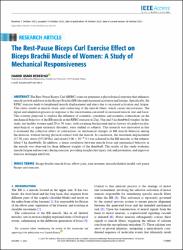| dc.contributor.author | Dereshgi, Hamid Asadi | |
| dc.date.accessioned | 2024-01-09T10:53:39Z | |
| dc.date.available | 2024-01-09T10:53:39Z | |
| dc.date.issued | 2023 | en_US |
| dc.identifier.citation | Dereshgi, H. A. (2023). The rest-pause biceps curl exercise effect on biceps brachii muscle of women: A study of mechanical responsiveness. IEEE Access. | en_US |
| dc.identifier.issn | 21693536 | |
| dc.identifier.uri | https://doi.org/10.1109/ACCESS.2023.3325669 | |
| dc.identifier.uri | https://hdl.handle.net/20.500.12294/4024 | |
| dc.description.abstract | The Rest-Pause Biceps Curl (RPBC) exercise generates a physiological response that enhances muscle growth and force in the Biceps Brachii (BB) through increased activation and fatigue. Specifically, the RPBC exercise leads to heightened muscle displacement and stress due to increased activation and fatigue. This stress results in muscle strain, and contracting of the muscle fibers, which causes microtrauma. The repair and adaptation process in response to this microtrauma can result in increased muscle size and force. This scrutiny purposed to explore the influence of isometric, concentric and eccentric contractions on the mechanical behavior of the BB muscle in the RPBC exercise at 2 kg, 3 kg and 5 kg dumbbell weights. In this study, ten healthy women aged 20 to 30 years, with a training background and no history of cardiovascular, neurological, or upper extremity disorders, were studied as subjects. This research was innovative in that it evaluated the collective effect of contractions on mechanical changes in BB muscle behavior during the exercise, without having physical contact with the muscle. In conclusion, the maximum displacement ( 37.56 mu m ), stress (355.89 Pa), and strain ( 3.06 x 10( -4) %) was achieved in the BB muscles as the subjects lifted 5 kg dumbbells. In addition, a linear correlation between muscle force and mechanical behavior in the muscle was observed for three different weights of the dumbbell. The results of this study evaluates muscle fatigue and recovery during exercise, providing insights into injury risk and prevention, and improves exercise technique and form. | en_US |
| dc.language.iso | eng | en_US |
| dc.publisher | Institute of Electrical and Electronics Engineers Inc. | en_US |
| dc.relation.ispartof | IEEE ACCESS | en_US |
| dc.identifier.doi | 10.1109/ACCESS.2023.3325669 | en_US |
| dc.rights | info:eu-repo/semantics/openAccess | en_US |
| dc.subject | Biceps Brachii Muscle Force | en_US |
| dc.subject | Elbow Joint | en_US |
| dc.subject | Joint Moment | en_US |
| dc.subject | Musculoskeletal Model | en_US |
| dc.subject | Est-Pause Biceps Curl Exercise | en_US |
| dc.title | The Rest-Pause Biceps Curl Exercise Effect on Biceps Brachii Muscle of Women | en_US |
| dc.title.alternative | A Study of Mechanical Responsiveness | en_US |
| dc.type | article | en_US |
| dc.department | Mühendislik ve Mimarlık Fakültesi, Biyomedikal Mühendisliği Bölümü | en_US |
| dc.authorid | 0000-0002-8500-6625 | en_US |
| dc.identifier.volume | 11 | en_US |
| dc.identifier.startpage | 116967 | en_US |
| dc.identifier.endpage | 116978 | en_US |
| dc.relation.publicationcategory | Makale - Uluslararası Hakemli Dergi - Kurum Öğretim Elemanı | en_US |
| dc.institutionauthor | Dereshgi, Hamid Asadi | |
| dc.authorwosid | AAT-7257-2021 | en_US |
| dc.authorscopusid | 57209736822 | en_US |
| dc.identifier.wosquality | Q2 | en_US |
| dc.identifier.wos | WOS:001092092900001 | en_US |
| dc.identifier.scopus | 2-s2.0-85174824788 | en_US |


















